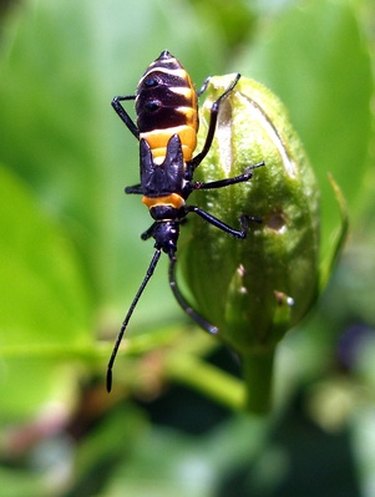
Asian Longhorned Beetles are originally found in countries such as Japan, Korea, and China. It is classified as a borer beetle, which drills deep into hardwood trees and infest and lay their eggs in wood. According to the Center for Invasive Species Research, it is assumed that the Asian Longhorned Beetle's first infestation of America came from unfinished packing materials that originated in China.
Direct Effects
Video of the Day
Asian Longhorned Beetles infest trees and the branches of trees, laying eggs inside of the deep tunnels they bore. The larvae eat the wood of the tree and burrow a series of passageways into the tree, causing the branches to weaken and fall off. This presents a physical danger to humans. When heavy snows or winds are present, the danger increases.
Video of the Day
Economic Effects
Asian Longhorned Beetles not only destroy valuable shade trees, but they can also destroy entire hardwood forests and trees of economic value, such as sugar maples.
When an infestation occurs, plants must be removed and completely destroyed to prevent further destruction. This quickly becomes costly for those responsible for destroying and replacing the trees.
Another financial aspect to consider are increased regulations on shipping material from China. Items are delayed and must go through rigorous procedures to be approved for use. Wood used for shipping must be heat treated, fumigated or treated with preservatives if they are to be used for products destined for the United States.
Fighting Back
Asian Longhorned Beetles currently affect New York, Brooklyn, Long Island and Chicago. Many of the species of trees in the northeastern United States are susceptible to attack by these beetles. Scientists and entomologists have developed different avenues to dissuade further attacks and infestation of the Asian Longhorned Beetle.
One complication in treating these infestations is due to the beetles' dormant periods. For a pesticide to work, it will need to be sprayed repeatedly over an infested area in order to be effective across the beetle's different life stages. One such pesticide allegedly killed bees in portions of Europe and is no longer used. Natural methods, such as the introduction of a species of beetle that preys on the Asian Longhorned Beetle, are currently under research and development. Another avenue under research is identification of chemical pheromones that attract male Asian longhorned beetles to females in order to develop traps.